Keep Calm and Carry Ohm
21/11/08 Day 8 - Agra
Keep Calm and Carry Ohm 21/11/08 Day 8 - Agra |
||
The moment I woke up this morning I wanted to see India's most iconic landmark, the Taj Mahal. I excitedly sprung out of bed and opened the curtains but all I saw was the hotel's manicured gardens. The hotel's literature said that you could marvel at the marble majesty of the Taj from here but reading further it continued to say "from a viewing platform". So on our way down to breakfast I couldn't let the opportunity pass and we climbed all the way up to the top. Above the rooftops of Agra in the hazy distance we saw the unmistakable dome of a true wonder of the world. We just stood there with beaming smiles across our faces. It felt so magical. |
| After having too much time on our hands it was quite embarrassing arriving late for our pick up in the foyer. It was our new alarm clock to blame as it had already lost 15 minutes over the last few days. Rob & Carol and our guide were waiting patiently for us beneath the giant chandelier. |
We clambered into a mini bus and drove the 1km from our hotel to a point 500m away from the entrance gates. Bhanu, our guide, explained that in an aim to reduce the pollution in the vicinity of the Taj Mahal no petrol or diesel fuelled vehicles were allowed any nearer. There was an array of options to shuttle us the short distance to the entrance gate from camels, elephants, donkeys, peddling rickshaws, or battery powered bus. Banhu got us onto the least adventurous as we hummed our way on a shuttle bus towards the ticket office at the East Gate. |
Our first glimpse of the stunning white marble perfectly aligned through the arch of the south entrance was absolutely exhilarating. It was such a spectacular illusion. The Taj Mahal was still quite some distance away yet the "looking through the keyhole" perspective made it appear far closer. It was fascinating to notice how the arch of Darwaza-i rauza perfectly matched that of the Taj Mahal. The accuracy of the design was astonishing. We stood here for a while whilst Bhanu filled us in on its fascinating history. |
| The grief stricken Mughal Emperor Shah Jahan built the Taj Mahal fulfilling his third wife Mumatz Mahal's dying wish. Her life ended whilst in childbirth with their fourteenth child, (of which only six survived) and with her last breath she asked Shah Jahan to build her a mausoleum more beautfiul than any the world had ever seen. She also slipped in another request asking Shah Jahan to promise to never marry again, to which he agreed and kept. This was a tragic love story. |
Shah Jahan certainly fulfilled his promise. This was the single most beautiful thing I had ever seen in my life. Bhanu had warned us that many visitors are overcome with emotion when they see the Taj Mahal for the first time. He wasn't lying. A heady cocktail of irrepressible excitement at simply being here; the astonishment at its sheer beauty and majesty; a surging sentiment over a classic love story; it all accumulated to overwhelm me. (Not that I have much alpha male emotional barriers. I cry at the "Britain's Got Talent" auditions!) I turned to Julie at the moment her tears breached their boundaries and trickled slowly down her cheek. It was such an inspirational moment. We hugged and cried and hugged some more. We were in the presence of something special and it felt wonderful. |
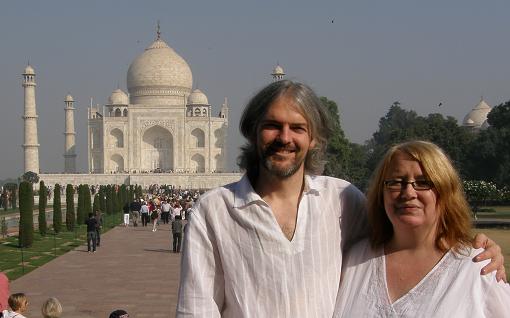 |
After Bhanu had taken photos of Julie and I and Rob and Carol, we began walking towards our goal. It was strange, almost implausible but despite strolling for quite some time we didn't feel like we were getting any closer. The sheer scale of the building was deceiving our perception of the distance. When we reached the lotus pool, halfway between the entrance and the Taj Mahal, Bhanu explained that this was the ideal location to benefit from the full view. Any nearer and we would begin to lose elements of the panorama. |
The lotus pond is now forever associated with a modern day tragic love story. Back in 1992 Diana Princess of Wales issued her heart-rendering statement of her solitude by sitting alone and forlorn on a bench at the edge of the pool. The pool is now busy with couples queuing up to have their photograph taken on the "Diana bench". Julie failed to see the attraction of sitting on a bench of such sorrow Of course not everyone sitting on the bench were there because of the Princess of Wales, it was actually the best position to have a photograph taken with the whole Taj Mahal behind you and without the interference of the crowds. |
| (Also, technically, the bench used isn't the Diana bench as she sat on the other side but I suppose that was immaterial.) |
|
He continued with the next chapter of the tragic tale of love and loss with a twist that I was not expecting. Rumour had it that Shah Jahan had begun planning his own mausoleum, an exact replica of the Taj Mahal but in a black marble. How mind-blowing would that have been! It was going to built on the opposite side of the Yamuna river with a marble causeway linking them together in their paradise. Excavations over the river in the area they call the Moonlight Garden uncovered large pieces of black marble adding some credence to rumour. Or was that just another rumour to perpetuate the myth? Myth or not the fact is Shah Jahan never got to build his dream. |
Bhanu led us to the base of the plinth upon which the Taj Mahal is built. Before stepping onto the white marble we either had to remove our shoes or wear comical paper socks over the top of our footwear. We followed Bhanu's lead and slipped on the socks. I was struggling to get them on. My size twelve sandals didn't fit that easily into the tearable paper bag. Then I heard a rip. |
|
Apparently the Mughals were great naturalists who believed that flowers were symbols of the divine realm, of heavenly paradise. |
| We had to queue a little to get inside the tomb chamber where a bottleneck of tourists had naturally built up. All the waiting was worth it however to see the marble sarcophagi of Emperor Shah Jahan and his beloved wife Mumatz Mahal laying side by side. (Their real grave is actually 30ft below in a crypt which is now closed to the public due to safety concerns.) As striking as they were their thunder was somewhat stolen by the octagonal screen that surrounded them. The intricate detail was utterly mesmerising especially when you consider that each panel was carved from a single piece of marble. |
Bhanu continue to talk about the accomplished work and the source of the materials used in creating such a jewel. "Gems from all corners of the Mughal Empire" he theatrically said. The delicate partition gave him the opportunity to demonstrate the translucent quality of the marble and one of the colourful gem stones. Rob produced his pocket torch and Bhanu shone the light through the other side of the screen. An orange bloom illuminated brightly as the whole flower filled with the light. It was the only stone to have this quality. I'll be damned if I can remember what stone it was?? We continued our clockwise tour around the tombs until we had reached the entrance once again. The inner chamber was flanked by four halls which in contrast to almost every other part of the Taj Mahal were rather plainly decorated. |
It felt strange posing with strangers but to finish off the photo shoot I handed Bhanu my camera so that I could also have a photo of the four of us. |
It had flowed from its source in Himalayan hills, avoiding the Ganges by flowing through Delhi arriving here in Agra before giving itself up to Mother India at Allahbad. |
I found the marble floor surprisingly cool on my feet despite baking in the sun. We walked all the way around the Taj Mahal before deciding to step down off the plinth and spend what little time we had remaining relaxing in the ornamental garden, the Char Bargh. We sat down facing the Taj Mahal. "Will you build me something like this when I die?" asked Julie. "Oh, absolutely," I said "but I've only ever built is a pizza oven. I suppose it's the same thing really only bigger!" |
Despite being full of visitors in never once felt overcrowded or too busy to be comfortable. In fact it often felt as if we were the only two there. We were in a world of our own when our gaze was fixed on the elegant beauty of the Taj. The fifteen minutes or so spent sitting in the garden was perfect. We could have sat there all day but it was soon time to get up and walk back towards the gateway. We met up with Rob and Carol near the Lotus pond and arrived at the rendezvous with Bhanu on time. With a steady flow of people pouring in through the main entrance we exited through a side door, turning around for one final look. |
Bhanu had also warned us not to be fooled by anyone selling marble pieces as it wouldn't even be proper marble and the colourful inlaid gemstones would have been pieces of porous stones soaked in food colouring. "We will be going to the Emporium next" he added "where you can buy the real thing" |
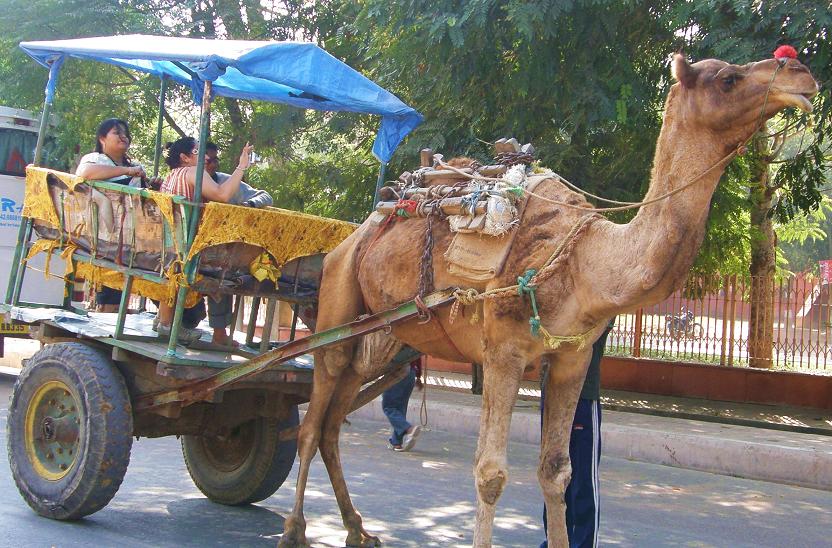 |
As we left on our buzzing battery bus we were entertained watching everyone else arriving on the back of an elephants, or in camel a cart or squeezed in the back of a large cycle rickshaw. |
I was certainly envious of their more adventurous mode of transport. We swapped our bus and set off for the marble centre in our diesel fuelled charabang. |
Next we were taken into the store where he showed us various examples of their work. "You can spill red wine or coca cola on it and it won't stain" he said and to prove his point he opened a half empty bottle of flat coke and poured it over the white marble table top. We all made the appropriate "ooh, we are impressed" noises. We were then followed around the store by a personal shopping assistant. Within a minute or so ours was visibly disappointed he had chosen us. We were completely disinterested and he knew he wasn't going to get a sale out of us. |
Rob and Carol on the other hand were keen on buying something and they decided on a very attractive design on white marble. There were some stunning examples on show. The large octagonal table tops were a bit out of our price bracket at nearly a thousand pounds! We did see a set of four coasters that we thought perhaps we could stretch to but at £60 they were still a lot of money for something just to place my mug on to avoid staining the bedside cabinet, especially when a beermat does the same trick! I was now beginning to get very hungry but thankfully it was time for food. |
A feast fit for an Queen for only 355 rupees. (Why couldn't they have called it after the King Shah Jahan?!) Julie wasn't at all hungry but feeling obliged to order something she went for Tadka Dhal which I managed to help her out with. |
Whilst browsing the menu Carol confessed to not being a big fan of spicy food. That could be quite a disadvantage whilst travelling in India! We steered her towards a mild palak spinach curry and after they removed the paneer cheese from it I think she enjoyed it. A small condiments tray on the table, filled with aniseed flavoured seeds to aid the digestion, caught my eye. It was a turning point in my perception of the swastika. Not once did I think Nazi paraphernalia. I found it to be a very attractive piece of plastic tableware and had to stop myself from slipping into my large bag. |
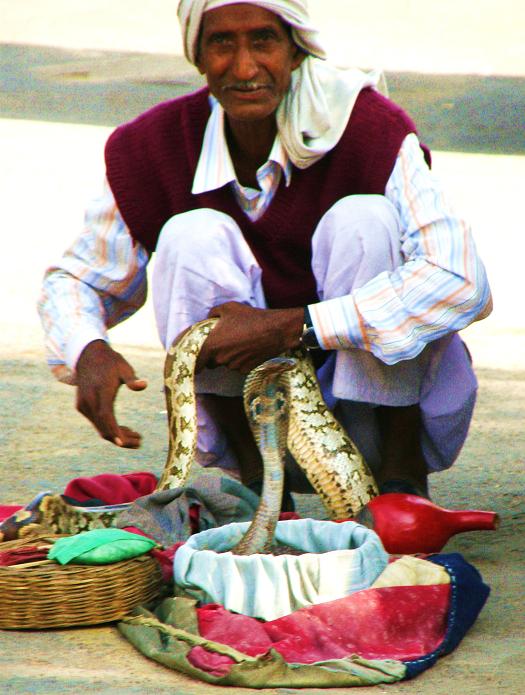 |
Beyond the prancing musicians we stopped to browse their little gift shop. We bought Rory and Tyler a small pop-up paper cobra that sprung up out of its little wicker basket. |
|
Moments later we saw the real thing popping out of a much bigger wicker basket. He also had a fat python in his hand. Julie gave it a very wide berth on the way back to the minibus. |
||
Along the way to our next attraction Bhanu amused us by saying that Agra wasn't a large city, it only has a population of 3.2 million, that's all! Birmingham, the UK's second largest city is only one million! |
Back to the history lesson. In 1558 the third Mughal Emperor Akbar the Great decided to relocate the capital to Agra. He built on top of an existing brick fort and created a palatial walled city. Emperors Jahangir and Shah Jahan added their own mark on extending the fort. Walking in through the arches of the Amar Singh gate was extremely atmospheric. It made the hairs on the back of my neck stand up. |
|
Before long we had come to a large courtyard where a public hall called Diwan-i-Aam stood at the far end. The emperor would have sat on the fabled Peacock Throne (which has long gone) and met his subjects. |
||
The succession of scalloped arches were quite hypnotic, like an optical illusion; like peacock tail feathers perhaps. It was fascinating, even if it left me feeling quite dizzy. |
||
The Musamman Burj was the "cell" in which he was incarcerated until his death. I had imagined a grim and miserable room with bars on the windows so I was certainly surprised to see such a lavishly decorated room with inlaid white marble as in the Taj Mahal and niches for candles and jewels. We shouldn't have felt cheated by the tragedy however as this was a gilded cage. He was held under house arrest left alone to suffer his loss. The loss of his freedom, all of his power, his three sons and the love of his life, Mumatz. Now that's more suffering that I would ever care to experience in one lifetime. |
We needn't have worried though as we had plenty of other opportunities to see to glorious sight of the magical Taj in the distance. We returned back through the Khas Mahal paying more attention to the view rather than the paintwork on the palace's marble ceilings. |
||
Next we entered the Jahangiri Mahal where the views of the Taj were equally breathtaking. Even from this distance and unusual angle the Taj Mahal looked impressive. |
||
Bhanu brought our attention back to Agra Fort when he explained that the Jahangiri Mahal was a zenana, an area built to house the emperor's numerous wives. The idea of having an extensive harem but also a "favourite" wife, one who you would build the most beautiful mausoleum the world had ever seen is a little strange to our conservative ways and customs . |
"It's a shame it's not been kept intact like the Grand Palace in Bangkok" said Julie. "That'll be the marauding invaders" I added. The Mughal's themselves were of course marauding invaders of their time and one of the spoils of war found here when the first emperor Babur captured the brick fort on this hill was the famous Koh-i-Noor diamond. The British then marauded and appropriated what was once the largest diamond in the world. The 105 carat stone can now be seen set with the Crown Jewels at the Tower of London. |
As we walked down to the Singh Gate we discussed what to do next. Bhanu asked if we'd be interested in visiting a market. "What would you like to buy from India?" he asked. "A dhal bowl" I replied. He looked at me confused. "But I don't know where." he conceded. Rob and Carol asked if they could return to the Taj Mahal for the sunset and after a little persuasion Bhanu agreed to take them. |
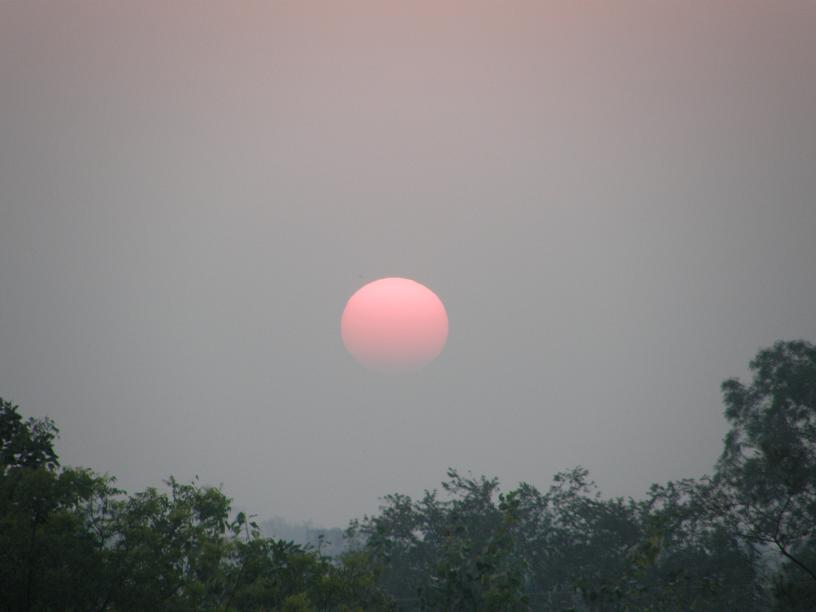 |
Eventually the sun's fading glow left the Taj behind and the moment was over. Time to move on and relocated to our room. After finding Julie asleep sitting up in bed I decided that we were far too tired to get all dressed up for supper. In a repeat of lunch we ordered exactly the same choices from room service. A rudely awoken Julie just went for a bowl of Tadka Dhal. |
"I'm not very hungry" she explained. I can't remember exactly the point she transferred her appetite over to me but she must have slipped it across when I was sleeping. I was so starving I went for the full Thali. It consisted of a Dhal Makhani, Paneer Tikka, Aloo Methi, rice, spiced yogurt, tomato and cucumber, and a dessert called Galub Jamin a super sweet doughnut submerged in honey . I loved every single delicious mouthful. |
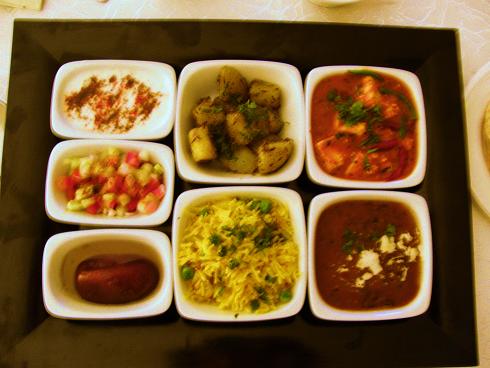 |
We were over a week into our Indian Odyssey and all the travelling was beginning to catch up with us. I was still eating when Julie decided to roll over and go to sleep and I followed her as soon as I found myself asleep with a pen in my hand half way through writing up today. It was only 9pm! |
| Next Day > | ||
|
ęCopyright 2000 - 2020 |